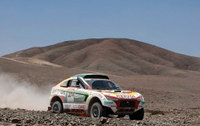Mechanics find fault & Roma maintains 4th
 Team Repsol Mitsubishi Ralliart’s Joan ‘Nani’ Roma and Lucas Cruz Senra (both Spain) survived what should have been the longest and potentially most difficult special stage of the entire 2009 Dakar Rally on Tuesday. They completed the 670km loop through the Atacama desert, that was shortened to 476km by event officials, in fifth place to maintain fourth in the overall classification.
Team Repsol Mitsubishi Ralliart’s Joan ‘Nani’ Roma and Lucas Cruz Senra (both Spain) survived what should have been the longest and potentially most difficult special stage of the entire 2009 Dakar Rally on Tuesday. They completed the 670km loop through the Atacama desert, that was shortened to 476km by event officials, in fifth place to maintain fourth in the overall classification.The Mitsubishi mechanics left no stone unturned to find the fault that had caused Roma’s overheating woes on the ninth stage and the ventilator fan was eventually repaired to rectify the problem.
Roma held a virtual sixth at the first passage control and a similar position through PCs three, four and five, before reaching the finish, adjacent to the bivouac, where hundreds of service teams, media and spectators were watching the action unfold at the end of the special from an elevated position on a giant dune.
Persistent fog prevented take off for safety helicopters
Robbie Gordon (USA) set the second fastest time on the special to reduce Roma’s hold on fourth position to 21m 25s, but Carlos Sainz (Spain) continued to head team mate Mark Miller (USA) by 27m 31s in the overall standings after setting the quickest time of the day.
The ASO permitted 312 teams to take part in today’s loop stage, with 142 bikes and quads, 109 cars and 61 trucks given permission to restart. Low-lying cloud and a sea mist again forced the delay of the special stage, which had been reduced from 670km to 476km the previous evening, on the grounds that some of the terrain was not challenging and the ASO preferred teams to have more time to tackle the tricky dunes en route.
But the fog persisted, meaning that the safety helicopters could not take off, and ASO officials were forced to delay the start of the stage by 2h 40m.
Stage 10 marks return to Argentina
Tomorrow (Wednesday) is the 10th leg of the 2009 Dakar Rally and marks the return to Argentina across the mighty Andes mountain range. Event organisers have warned that the emphasis will be on accurate navigation, as a 20km liaison takes teams into a 215km special stage, finishing just after the village of Carrera Pinto.
Service trucks and assistance vehicles will reach 4,250 metres above sea level, before crossing the border at around 4,160 metres and head on towards the following night halt at La Rioja.
Competitors, meanwhile, will experience a 445km liaison section to their overnight halt at the spa town of Fiambalá, which is the first and only Marathon-type stage on this year’s Dakar. The sinuous passage will cross the Col San Francisco at an altitude of around 4,748 meters.
The liaison route climbs over winding tracks through the Claudio Gay mountain range and heads towards Hosteria Murray before reaching Las Grutas and descending through Cortaderos and Chaschuil to Fiambalá, which is in the Catamarca province and lies 1,520 metres above sea level.

